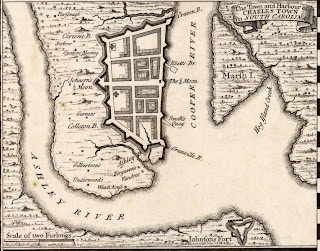JULY 6 & 7, 2012
CHARLESTON, SOUTH CAROLINA
Charleston, South Carolina (JFK+50) We are spending the final day & night vacationing in downtown Charleston, South Carolina.
In today's post, JFK+50 will present a short history of one of the most beautiful cities in the world.
CHARLES TOWN, named in honor of Charles II, King of England, Scotland & Ireland, was founded in 1670.
Ten years later the land surrounding the intersection of MEETING & BROAD STREETS was set aside for a civic square.
By the mid 1700s, the city was not only a major economic center, but also the cultural center of the Old South.
Map of Charleston (1733)
Library of Congress
The 1st Anglican Church, St. Philip's Episcopal, was built in 1682. Its' steeple became a target for British warships during the American Revolution of the 1770s.
St. Philip's Episcopal Church
Charleston, South Carolina
Photo by John White (2012)
Perhaps Charleston is most famous, however, for her role in the American Civil War.
Here on December 20, 1860, the SOUTH CAROLINA GENERAL ASSEMBLY voted to SECEDE from the Union of States, and on April 12, 1861 the CIVIL WAR began here with the Confederate assault on Fort Sumter located in Charleston harbor.
Charleston Historic Marker
Meeting Street
Photo by John White (2012)
While the city, unlike the Confederacy, survived the Civil War, it was almost destroyed by earthquake in 1886.
In 1989, Hurricane Hugo damaged about 75% of the homes in the Historic District.
JFK+50 COMMENT
We hope to visit this beautiful & historic city many times over the next few years as our daughter Jennifer pursues a law degree from Charleston School of Law.
Jennifer Leigh White
Charleston, South Carolina
July 4, 2012
Photo by John White
In today's post, JFK+50 will present a short history of one of the most beautiful cities in the world.
CHARLES TOWN, named in honor of Charles II, King of England, Scotland & Ireland, was founded in 1670.
Ten years later the land surrounding the intersection of MEETING & BROAD STREETS was set aside for a civic square.
By the mid 1700s, the city was not only a major economic center, but also the cultural center of the Old South.
Map of Charleston (1733)
Library of Congress
The 1st Anglican Church, St. Philip's Episcopal, was built in 1682. Its' steeple became a target for British warships during the American Revolution of the 1770s.
St. Philip's Episcopal Church
Charleston, South Carolina
Photo by John White (2012)
Perhaps Charleston is most famous, however, for her role in the American Civil War.
Here on December 20, 1860, the SOUTH CAROLINA GENERAL ASSEMBLY voted to SECEDE from the Union of States, and on April 12, 1861 the CIVIL WAR began here with the Confederate assault on Fort Sumter located in Charleston harbor.
Charleston Historic Marker
Meeting Street
Photo by John White (2012)
While the city, unlike the Confederacy, survived the Civil War, it was almost destroyed by earthquake in 1886.
In 1989, Hurricane Hugo damaged about 75% of the homes in the Historic District.
JFK+50 COMMENT
We hope to visit this beautiful & historic city many times over the next few years as our daughter Jennifer pursues a law degree from Charleston School of Law.
Jennifer Leigh White
Charleston, South Carolina
July 4, 2012
Photo by John White



